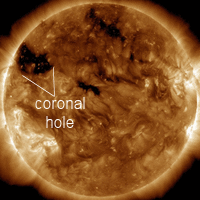SUNSET SKY SHOW: When the sun goes down tonight, step outside and look west. Venus and the slender crescent Moon are gathering in the twilight sky for a beautiful conjunction. Sky watchers across North America will see them only 1o to 3o degrees apart, while observers in far-South America will witness a full-fledged occultation. The Moon will pass directly in front of Venus. It's a nice way to end the day. Astronomy alerts: text, voice.
RIM FIRE FROM THE EDGE OF SPACE: The Rim Fire overlapping Yosemite National Park has now burned more than a quarter of a million acres (390 sq. miles), and according to the US Forest Service it may continue to grow, thanks to low humidity and other conditions. Smoke from the wildfire is affecting an even greater area. On Sept. 1st, the students of Earth to Sky Calculus sent a camera to the edge of space for a wide-angle shot of the smokey plumes:
This photo, which was taken from the payload of a helium balloon 110,000 feet above Earth's surface, captures more than 10,000 sq. miles of terrain. About half is covered with filaments of smoke from the Rim Fire. There is far more smoke in the image than cumulus clouds. In recent weeks, shifting wind patterns have drawn the plumes back and forth across the mountain towns of the eastern Sierra Nevada, prompting frequent air quality warnings in some places. This photo shows that helium balloons can be effective tools for monitoring the location of the smoke.
The black bars and popped red balloon jutting into the top of the photo are part of another ongoing experiment. The students have been dispersing small amounts of powder and ash into the stratosphere to measure the "hang time" of tiny particles. The particles ascend inside a small balloon, which pops at altitude to scatter its contents at the edge of space. As NASA studies of an exploding asteroid over Russia have confirmed, fine ash deposited in the stratosphere does not immediately fall to the ground. It circles the globe for months or more, usually landing harmlessly in remote ocean areas.
More information about the group's edge of space experiments may be found on Facebook.
Realtime Space Weather Photo Gallery
MOON PROBE BLASTS OFF: NASA's LADEE spacecraft is headed toward the Moon after launching on a Minataur V rocket Friday night from NASA's Wallops Flight Facility in Virginia. The launch, which occured at 11:27 pm EDT, was widely visible along the US east coast from Maine to the Carolinas. Ben Cooper on took this picture of the rocket flying over the Empire State Building in New York:
"As seen from the Top of Rockefeller Center, LADEE launches to the moon aboard Orbital Sciences Minotaur V rocket," says Cooper. "[It soared] over the blue-and-green Empire State Building, lit for the US Open of tennis."
The launch kicks off LADEE's mission to investigate the Moon's atmosphere. Yes, the "airless Moon" has an atmosphere. It is ten thousand billion times thinner than Earth's, but nevertheless there. Apollo astronauts actually saw it with their own eyes.
LADEE, short for "Lunar Atmosphere and Dust Environment Explorer," will circle the Moon for 100 days to assay the lunar atmosphere. Instruments onboard the spacecraft will look for signs of humidity, electrified dust, and atoms hopping across the lunar surface. A NASA video about LADEE previews the mission

Solar wind
speed: 375.5 km/sec
density: 2.2 protons/cm3
explanation | more data
Updated: Today at 0026 UT
X-ray Solar Flares
6-hr max: B3 2125 UT Sep08
24-hr: B7 1538 UT Sep08
explanation | more data
Updated: Today at: 2359 UT
![]()
Daily Sun: 08 Sep 13
The Earthside of the sun is quiet. Solar activity is low. Credit: SDO/HMI
![]()
Sunspot number: 35
What is the sunspot number?
Updated 08 Sep 2013
Spotless Days
Current Stretch: 0 days
2013 total: 0 days (0%)
2012 total: 0 days (0%)
2011 total: 2 days (<1%)
2010 total: 51 days (14%)
2009 total: 260 days (71%)
Since 2004: 821 days
Typical Solar Min: 486 days
Update 08 Sep 2013
The Radio Sun
10.7 cm flux: 99 sfu
explanation | more data
Updated 08 Sep 2013
![]()
Current Auroral Oval:
Switch to: Europe, USA, New Zealand, Antarctica
Credit: NOAA/POES
![]()
Planetary K-index
Now: Kp= 0 quiet
24-hr max: Kp= 3 quiet
explanation | more data
Interplanetary Mag. Field
Btotal: 3.5 nT
Bz: 0.8 nT south
explanation | more data
Updated: Today at 0027 UT
![]()
Coronal Holes: 07 Sep 13
A coronal hole is emerging over the NE limb of the sun. Credit: SDO/






